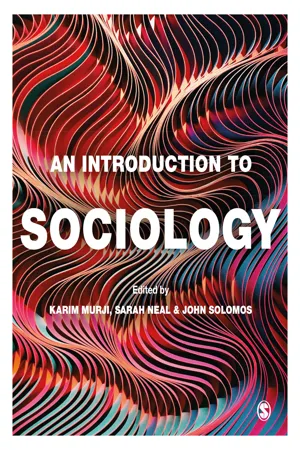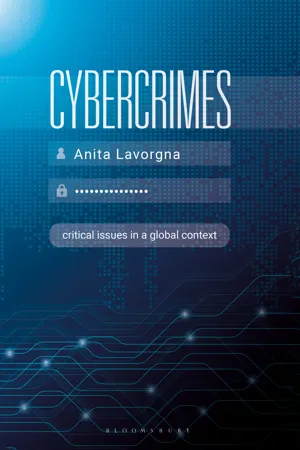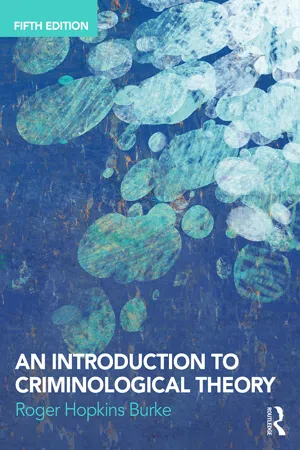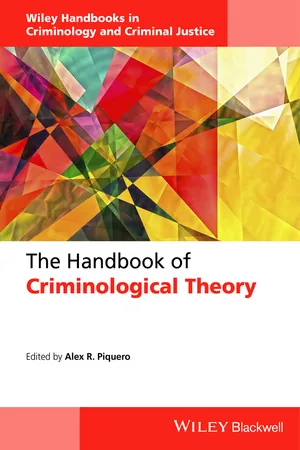Social Sciences
Contemporary Crime
Contemporary crime refers to criminal activities that are prevalent in modern society. These crimes are often associated with technology, such as cybercrime and identity theft, but can also include traditional crimes such as theft and assault. Understanding contemporary crime is important for developing effective strategies to prevent and respond to criminal activity.
Written by Perlego with AI-assistance
Related key terms
5 Key excerpts on "Contemporary Crime"
- eBook - ePub
- Karim Murji, Sarah Neal, John Solomos(Authors)
- 2021(Publication Date)
- SAGE Publications Ltd(Publisher)
4 What is Sociological about Crime? Eamonn CarrabineLearning Objectives
- To understand the key sociological perspectives on crime and how they have developed over time.
- To enable critical reflection on the differences between them and grasp some of the ongoing controversies in the field.
- To become aware of the leading figures and schools of thought in this area of sociology in order to be a confident and critical student of their ideas.
- To locate analyses of crime in broader sociological debates.
- To be able to scrutinize broader criminological ‘texts’ (such as film, TV, press, internet) and make sense of them through the theories discussed.
Framing Questions- In what ways, if any, is crime normal?
- Is deviance still a useful concept?
- What are the relationships between crime and place?
- How do classical ideas impact on more contemporary approaches?
- Why do men commit more crime than women?
IntroductionThe question of crime is one that has the capacity to stretch the sociological imagination endlessly. Crime is a widely used word, a central theme in popular culture and a crucial dynamic shaping the political landscape. Yet, for all the seeming simplicity, there lies considerable complexity and controversy at the heart of the concept of crime. The term ‘crime’ appears in public debate and popular culture as if it is straightforward and obvious what it means, but the concept has many meanings and is rooted in certain social processes that have powerful ramifications.Mapping the TerrainCrime is always socially defined. Inevitably, this proposition provokes debate, and several competing approaches have been identified, ranging from a ‘legal-consensus’ definition through to one that is best understood as both ‘critical’ and ‘utopian’ (Greer and Hagan, 2001: 208–13). The differences can be summarized as follows:- The legal consensus
- eBook - ePub
Cybercrimes
Critical Issues in a Global Context
- Anita Lavorgna(Author)
- 2020(Publication Date)
- Bloomsbury Academic(Publisher)
This chapter provides a brief overview of a selection of criminological theories — in other words, a brief excursus on how scholars have looked at crime through history – that are key for the study and the understanding of cybercrimes. Of course, this book does not intend to be a book on theories; this chapter does not aim to engage in in-depth or exhaustive discussions about theoretical developments, their value and their critiques. Indeed, there are a number of excellent handbooks and primers that could assist you in this (see, among many, Williams & McShane 2010; Chamberlain 2015). Rather, this chapters wants to offer a brief recap of major criminological approaches to students in criminology who might have already encountered them in other modules and a crash course introducing some core criminological ideas to those readers who come from different backgrounds. Most of these approaches have been applied to cybercrimes, and you might encounter them later on in this book. In any case, you are encouraged to keep these theoretical approaches in mind when thinking about a cybercrime event: you can consider these theories as lenses thought which to think about the world, and depending on the lenses you put on, you could see different facets of the social reality and think about a cybercrime problem from different angles. A sound theoretical framework can, in fact, guide analyses and provoke critical thinking on complex topics. Theories matter not only to analyse the way others have looked at crime through different social and intellectual contexts but also to guide us in developing and testing solutions to present-day crime problems. Theories of crime are not merely part of academic debates, they are embedded in our daily lives. Every time we discuss news of a crime, hear a politician comment on crime policies or see a police officer patrolling a specific geographic area, there is a particular assumption about crime behind these events.A selection of fundamental ‘traditional’ criminological approaches will be presented by gathering them according to their different focus (for instance, approaches that emphasise the role of free will vs. approaches that emphasise the influence of social or psychological aspects on criminal behaviour). A section on ‘new’ theories developed specifically for crime in cyberspace will follow. While there are a variety of approaches to the study of crime and its causes (criminality can be a core interest of legal scholars, phycologists, economists and even architects), over the last century and more criminology has been oriented towards sociology in studying crime and its causes. Furthermore, it has to be admitted that for many years the study of criminological theories (or, to be more precise, its international recognition) has been tremendously Anglo-centric. Consequently, we will focus mostly on sociological approaches that have been developed in the United States and the United Kingdom –` a clear limitation of this chapter that is nonetheless necessary so as not to exceed the scope of this book.We will briefly note the historical and social context in which a theory originates, something important to keep in mind as theorists do not live in isolation and their ideas are often the direct result of the broader environment. It is worth emphasising that the theories covered here are all scientific theories, meaning that they are supported by empirical evidence, systematic observations and logical soundness, and they aim for objectivity. You will see that, in explaining the causes of crime, theories can have a different level of abstraction (Williams & McShane 2010): for instance, they can have a broad scope and look at the social structure or its effect (‘macro’, or structural, theories), or they can look at the individual level or at how someone becomes a criminal (‘micro’, or process, theories). Moreover, some theories assume the presence of consensus (of values and beliefs) in society, while others hypothesise the existence of a conflictual society. Table 3.1 - eBook - ePub
- Roger Hopkins Burke(Author)
- 2018(Publication Date)
- Routledge(Publisher)
Keith Hayward and Jock Young (2012) respond to the frequent criticisms of cultural criminology that it has little potential for crime policy. They observe that this theoretical perspective is in an appreciative approach that totally eschews ‘correctionalism’, although that does not inevitably mean to romanticize the offender, nor does it necessitate a non-interventional approach to crime. The emphasis is on the cultural meanings of the activities to those doing the crime.Young (2011) recognizes the complete neglect of the cultural nature of crime in the current predestined actor model-dominated criminological orthodoxy in the USA, in particular, which invariably involves entirely inadequate attempts to measure – and sometimes the collection of – toxic data. With this in mind, Hayward and Young (2012) observe that the issue becomes not whether cultural criminology is capable of providing legitimate policy interventions but rather whether or not much of the current funding directed at positivistic intervention is simply a waste of money.SUMMARY OF MAIN POINTS
- Cultural criminology seeks to explain crime and criminal behaviour and its control in terms of culture, with the focus on the continuous generation of meaning around interaction where rules are created and broken.
- Cultural criminology studies the way that some cultures have come to be designated as deviant and thus has been heavily influenced by labelling theories.
- Cultural criminology uses everyday existences, life histories, music, dance and performance as databases to discover how and why certain cultural forms become criminalized.
- Katz (1988) writes about the ‘seductions of crime’ in which disorder becomes in itself a ‘delight’ to be sought after and savoured and where the causes of crime are constructed by the offenders themselves in ways that are compellingly seductive.
- Presdee (2000) captures the interrelationships between pleasure and pain through his notion of ‘crime as carnival’ in which the latter is a site where the pleasure of playing at the boundaries is clearly catered for.
- Hopkins Burke (2007) introduces the term ‘the schizophrenia of crime’ to refer to the apparently contradictory duality of attitude to criminal behaviour that has become endemic in contemporary societies characterized by the postmodern condition.
- David Garland (1996) has observed that, as crime has come to be more frequent, it has ceased to be an exceptional or pathological event that surprises us when it occurs, but has become instead a standard, normal, background feature of our lives.
- eBook - ePub
The Process and Structure of Crime
Criminal Events and Crime Analysis
- Robert F. Meier, Leslie W. Kennedy, Vincent F. Sacco(Authors)
- 2018(Publication Date)
- Routledge(Publisher)
1Crime and the Criminal Event Perspective 1 Robert F. Meier Leslie W. Kennedy Vincent F. SaccoIntroduction
A comprehensive model of crime must be attentive to offenders and victims as well as to the contexts within which they interact. However, most criminological theory and research has failed to conceptualize these elements in ways that emphasize their interrelatedness. The failure to consider simultaneously offenders, victims, and contexts has created an awkward situation for analysts of crime. It is especially ironic in view of the continuing interest in the topic of theoretical integration both in sociology (Alexander et al., 1987) and criminology and deviance (Clarke and Felson, 1993; Bernard, 1990; Messner et al., 1989). As a result of a more comprehensive view, three bodies of literature in the sociology of deviance have laid claim to the label “theoretical.”The most venerable of these approaches is concerned with the conditions that influence persons to violate the law. Writers in this tradition have implicated an extensive array of correlates and causal agents from genetic and psychological factors, including low self-control, to supra-individual factors such as group membership patterns, economic disadvantage, and social structural strain (see Gottfredson and Hirschi, 1990; Kornhauser, 1978).A second, more recent, literature has focused on the social, demographic, and behavioral contingencies that are associated with variations in risk of criminal victimization (Cohen and Felson, 1979; Hindelang et al., 1978). These theories have identified such factors as target attractiveness, guardianship, and criminal opportunity as significant determinants of the spatial and temporal distribution of victimization risks (Miethe and Meier, 1994).A third, if less extensive, literature directs theoretical attention toward the social situations out of which criminal outcomes emerge. Arguments derived from this theoretical tradition have identified victim-offender interaction (Wolfgang, 1958), situated transactions (Luckenbill, 1977), and offenders’ definitions of the situation (Clarke and Felson, 1993; Cornish and Clarke, 1986) as key situational characteristics that are related to crime outcomes. Other writers have pointed to the physical context in which the crime has occurred (environmental crime prevention) (Brantingham and Brantingham, 1991), the community (Sampson, 1995), and neighborhood conditions (Bursik and Grasmick, 1993) that are correlated with crime. - eBook - ePub
- Alex R. Piquero(Author)
- 2015(Publication Date)
- Wiley-Blackwell(Publisher)
1 Introduction: Theory and Contemporary Criminology Charles R. TittleThe word “theory” means different things to different contemporary criminologists, depending on their philosophies about the nature of criminology, what it is attempting to accomplish, and how they think criminology ought to be done. Diversity is evident from the presence of at least seven differing “philosophies of the enterprise,” expressed in distinct “models” for doing criminology. The seven approaches include: (1) theoretical science; (2) problem solving; (3) “verstehen” analysis; (4) descriptive approaches; (5) critical work; (6) nihilistic thinking; and (7) amelioration. Yet, there does appear to be a dominant paradigm.In the following pages, I will briefly describe six of the styles of contemporary criminology and assess the meaning and importance of theory in each. However, my description of theoretical science is far more extensive than it is for the other six because theoretical science seems to be the most widely endorsed, even if not always actually practiced, mode of work in contemporary criminology. While all seven of the models to be discussed have an established place in the criminological landscape, are represented by strong advocates, contain powerful intellectual challenges, have produced important results, and command a degree of influence, most criminology seems to follow, to one degree or another, the model of science. Of course, classifying scholars and/or their products into camps is always somewhat arbitrary, and the relative popularity of the various modes of work may be undergoing change. Nevertheless, for now I will follow the classification scheme outlined above in trying to describe theory and its uses in contemporary criminology.
Learn about this page
Index pages curate the most relevant extracts from our library of academic textbooks. They’ve been created using an in-house natural language model (NLM), each adding context and meaning to key research topics.




